 |
|
|
|

|

|
Yiddish radio geeks of a bygone world |
|
|
|
|
I was sorting out some of the accumulated
stuff in my drawers of collectible technology, and ran into an old,
smudged-gray photocopy of an even older document – the cover of an
old booklet, bearing a quaint drawing of an antenna, radio set and
horn loudspeaker that blares the title, in Yiddish: “Der Yudisher Radio Amateur No.1”. I remember vaguely where I got this: back in the seventies I’d been an active radio ham, and I went to the National |
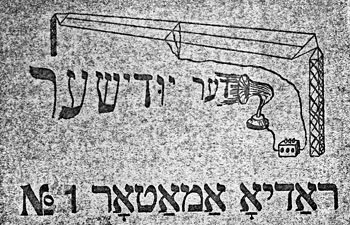 |
|
|
|
Library in Jerusalem to check whether they had any books on my hobby. They didn’t have much, but the subject catalogue did have a card that led me to this skinny pamphlet, with a foldout sheet of illustrations. I found it amusing enough to prompt me to make this copy: |
|
|
|
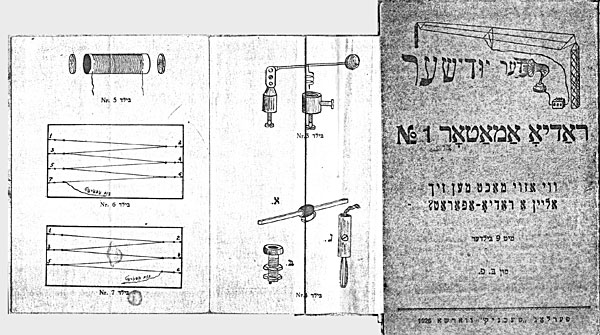 Click photo to enlarge The cover translates as follows: |
|
|
|
|
The Jewish Radio Amateur No.1 |
|
|
|
|
I wish I’d Xeroxed the entire booklet, but I hadn’t. The copy I have only shows the extended foldout, giving us a peek at five of the nine figures. These shows two large wire antenna configurations and some components, of which the one in “Bild Nr. 3” is more than enough for any radio hobbyist (or historian) to know what the proposed “Radio Apparat” was like. This is the unmistakable “Cat whisker” Galena crystal detector of a crystal radio set, a favorite first project for a young radio experimenter. I had built my first such set when I was maybe six, and you can see here (below, right) a wonderful one in my collection that I acquired in an antique shop in London. The cup in Fig. 3 holds the Galena (Lead Sulphide) crystal, and the hinged rod is manipulated to make the coiled metal whisker touch just the right point on the surface of the crystal to rectify the signal and allow a tinny voice to be heard in one’s headphones. You can see an identical device in the middle photo below. |
|
|
|
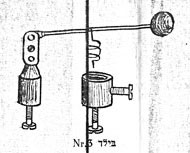
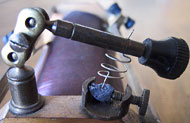
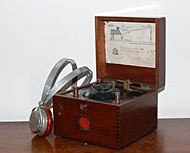 Detector photo credit: F1jmm, shared via CC license Click photo to enlarge |
|
|
|
So what was this “Yudisher Radio Amateur”
magazine? Were there more issues following No. 1, and did they go
beyond a simple receiver to elaborate on transmitting gear? Who were
its readers, and how many did it have? I doubt we’ll ever
know; there can’t have been many of them, and they’d be at least 100
years old by now. But this modest photocopy does tell us that they
had existed: that there were in Poland in the twenties some Jewish
kids who were attracted to the wonderful (and, at that time, quite
new) hobby of amateur radio; that some had an interest in building
their own equipment, and that at least one of them had been
enterprising enough to issue a hobbyist magazine that might
exuberantly proliferate his passion to other kids in his community.
These were, clearly, geeks – the earliest generation of geeks in an
ancient nation that in our own times had gone on to create an
incredible hi-tech hub, one that B.F. could not possibly have
imagined. It saddens me a little that we’ll never learn who B.F. himself was, and what had become of him. Given where the flourishing Jewish community in Warsaw would be headed in the next decade, we can fear the worst... Still, I’d like to hope that this guy, and at least some of his readers, had survived to see their fledgling field of interest grow into the key technology that had led to the world of today. Anyone who could build -- by themselves -- a radio apparatus would surely enjoy witnessing that! |
|
|
|
|
|
|
|
Home | HOC | Fractals | Miscellany | About | Contact Copyright © 2011 N. Zeldes. All rights reserved. |
|